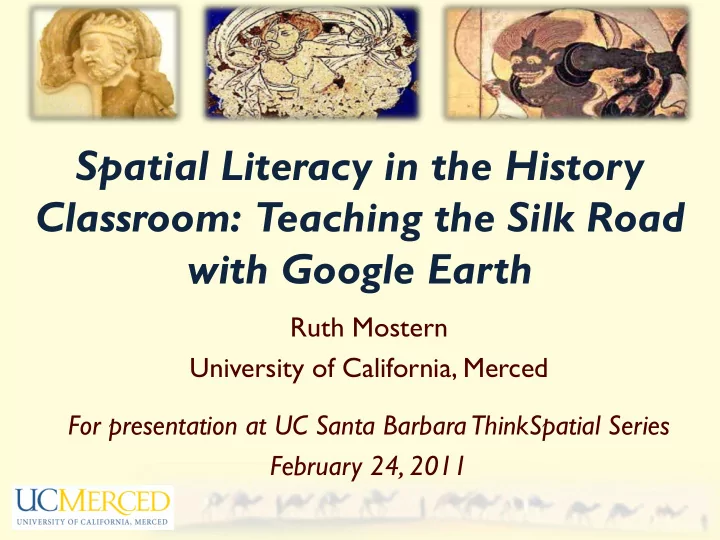

Spatial Literacy in the History Classroom: Teaching the Silk Road with Google Earth Ruth Mostern University of California, Merced For presentation at UC Santa Barbara ThinkSpatial Series February 24, 2011
“ Historians specialize in tracing and accounting for change over time. At least in principle, historians also recognize that history unfolds through space, yet it is fair to say that we have found it more cumbersome, and perhaps less important, to trace spatial relations than to trace temporal relations.” --Peter Bol , “Putting History in Geography,” (2004) Actually, historians don’t even have a model for HOW to account for space.
Spatial Literacy and History • Doreen Massey: “What might it mean…to question that habit of thinking of space as a surface? If, instead, we conceive of a meeting-up of histories, what happens to our implicit imagination of time and space?” • Tim Ingold : “The landscape is constituted as an enduring record of – and testimony to – the lives and works of past generations who have dwelt within it, and in so doing, have left there something of themselves.” Sarah Fanelli , “Map of My Day,” 1995. From The Map Book , which charts various facets of a child’s world and inspires kids to create maps of their own.
• Michael Curry, “T oward a Geography of a World Without Maps: Lessons from Ptolemy and Postal Codes” – a way out of the space versus place stalemate and a way to think about spatio-temporal integration. • Three modes of thinking about the world: – Choros (names and regions) – Topos (travels, itineraries, and relationships) – Geos (mathematically oriented maps of continuous space) A hand reconstruction of postal carrier routes, from a 1993 academic article.
The State of the Art? From Jerry Bentley and Herb Ziegler, Traditions and Encounters
Erica Neuhaus, History 10 (World History to 1450), UC Merced, Fall 2006
History 108: The Silk Road The Baburnama (c. 1540s), by Jonathan Munguia • An upper division undergraduate course. Every Monday a seminar, every Wednesday a lab. No technical prerequisites. • Each student chose a Silk Road travel narrative and completed a series of assignments leading to a KML due at the end of the semester. – Prospectus/Bibliography – Gazetteer – Episodes (History Engine) – Ten-page research paper – KML
Lab Slide Example 1 Right click on the file in Google Earth > Save Place As > Save File.
Lab Slide Example 2 The overlay is too big Move from and too far the corner to south. resize the image. Move from the edges to Move from the change the middle to pan dimensions. the entire image.
Final Project KML..an Atlas! • Based on a detailed rubric to Rubric Categories provide clear standards and guidelines and support review and 1. Writing assessment. Episodes Paper • An authored document with a title 2. Spatial Reasoning and Visualization and legend, which illustrates a Gazetteer/Point Locations particular approach to the travel Google Earth Cartography narrative and supports a research 3. Storytelling and Integration paper.
The Travels of Benjamin of Tudela (c. 1160s), by Jesus Carillo
The Rubric
Lessons Learned The students succeeded in • Alexander the Great (356-322 BCE), by Patrick Swisher historical spatial reasoning, historical research, and Google Earth authoring. • The class exceeded my most optimistic expectations! It was a lot of work, but it was worth it. The Google Earth tasks that were • hard for them were: – Using Spreadsheet Mapper – Understanding the difference between KML editing (for placemark behavior) and HTML editing (for popup content) – Working with time
Student Survey Thank you to the UC Merced Center for Teaching and Research Excellence for supporting a research assistant to observe the course and to survey and interview the students. “Compared to a normal history class without a digital and spatial component, how much have you learned about history by integrating spatial reasoning and map design into your work this semester?”
• “It allows us to view different regions and see how cultures spread out through history.” • “It’s more interactive and forces the student to be more engaged in his/her work.” “The spatial approach helps put history into perspective.” • “When I become a teacher, I will definitely use tools like the ones we • have learned this semester in my own classes-they help put a physical location with historical texts.” • It is sooooo nice to use Google Earth in learning about history and to see locations visually. It helps to make the ideas easier to grasp.” • “It was one of my favorite courses to date. I have shown my finished project off to many friends and family and when I teach in the future I want to do something similar.”
Google Earth Limitations • A timestamping interface! • Spreadsheet-based data entry (I tried Spreadsheet Mapper . I’ll look at Fusion Tables next time) A content authoring • interface for placemark pop-ups, with image management. Groups in Google Earth • Community. • A legend builder. Xuanzang (602-664), by Whitney Thorpe
Next Steps Anthony Jenkinson (1529-1610), by Tim Bell • Create a website with lab slides, the rubric, and exemplary student work. • Write an academic article and reports about this course methodology.
http://www.youtube.com/watch?v=_7I2BJBrLAU
Recommend
More recommend